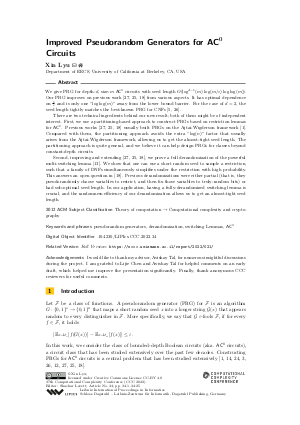@InProceedings{lyu:LIPIcs.CCC.2022.34,
author = {Lyu, Xin},
title = {{Improved Pseudorandom Generators for AC⁰ Circuits}},
booktitle = {37th Computational Complexity Conference (CCC 2022)},
pages = {34:1--34:25},
series = {Leibniz International Proceedings in Informatics (LIPIcs)},
ISBN = {978-3-95977-241-9},
ISSN = {1868-8969},
year = {2022},
volume = {234},
editor = {Lovett, Shachar},
publisher = {Schloss Dagstuhl -- Leibniz-Zentrum f{\"u}r Informatik},
address = {Dagstuhl, Germany},
URL = {https://drops.dagstuhl.de/entities/document/10.4230/LIPIcs.CCC.2022.34},
URN = {urn:nbn:de:0030-drops-165963},
doi = {10.4230/LIPIcs.CCC.2022.34},
annote = {Keywords: pseudorandom generators, derandomization, switching Lemmas, AC⁰}
}

 Creative Commons Attribution 4.0 International license
Creative Commons Attribution 4.0 International license





